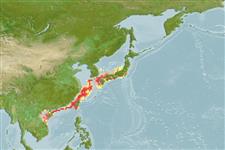>
Ovalentaria/misc (Various families in series Ovalentaria) >
Pomacentridae (Damselfishes) > Chrominae
Etymology: Chromis: Greek, chromis = a fish, perhaps a perch (Ref. 45335); onumai: Named for Hisashi Onuma, who first discovered the species..
Environment: milieu / climate zone / depth range / distribution range
Écologie
marin récifal; profondeur 51 - 90 m (Ref. 75861). Temperate
Northwest Pacific: Taiwan and Japan.
Taille / Poids / Âge
Maturity: Lm ? range ? - ? cm
Max length : 12.6 cm SL mâle / non sexé; (Ref. 75861)
Description synthétique
Clés d'identification | Morphologie | Morphométrie
Épines dorsales (Total) : 14; Rayons mous dorsaux (Total) : 12 - 13; Épines anales: 2; Rayons mous anaux: 12 - 13; Vertèbres: 26. This species is characterized by the following: D XIV, 12-13; A II, 12-13; pectoral fin rays 19-20; 3 spiniform caudal fin rays; 16-17 tubed lateral line scales; gill rakers 5-7 + 19-20 = 25-27; white spots about a pupil size posteriorly, 1 at rear base of dorsal fin, another at the rear base of anal fin, and the third at mid base of caudal fin (these 3 spots usually fading after death, but may be visible as a pale area on preserved specimen) (Ref. 75861).
Life history characteristics for the family specify that this group is oviparous, with distinct pairing during breeding (Ref. 205). Eggs are demersal and adhere to the substrate (Ref. 205). Males guard and aerate the eggs (Ref. 205).
Life cycle and mating behavior
Maturities | Reproduction | Spawnings | Egg(s) | Fecundities | Larves
Oviparous, distinct pairing during breeding (Ref. 205). Eggs are demersal and adhere to the substrate (Ref. 205). Males guard and aerate the eggs (Ref. 205).
Senou, H. and T. Kudo, 2007. A new species of the genus Chromis (Perciformes: Pomacentridae) from Taiwan and Japan. Bull. Nat. Mus. Nat. Sci. Ser. A. Suppl. 1:51-57. (Ref. 75861)
Statut dans la liste rouge de l'IUCN (Ref. 130435)
Menace pour l'homme
Harmless
Utilisations par l'homme
Outils
Articles particuliers
Télécharger en XML
Sources Internet
Estimates based on models
Preferred temperature (Ref.
123201): 17.2 - 23.7, mean 21.9 °C (based on 22 cells).
Phylogenetic diversity index (Ref.
82804): PD
50 = 0.5000 [Uniqueness, from 0.5 = low to 2.0 = high].
Bayesian length-weight: a=0.01778 (0.00796 - 0.03971), b=2.99 (2.81 - 3.17), in cm total length, based on LWR estimates for this Genus-body shape (Ref.
93245).
Niveau trophique (Ref.
69278): 3.0 ±0.1 se; based on size and trophs of closest relatives
Résilience (Ref.
120179): Haut, temps minimum de doublement de population inférieur à 15 mois (Preliminary K or Fecundity.).
Fishing Vulnerability (Ref.
59153): Low vulnerability (10 of 100).
